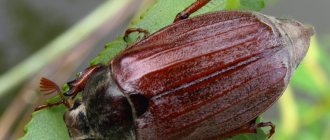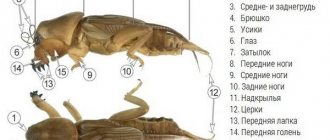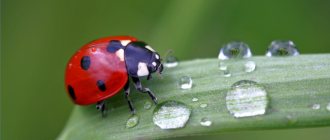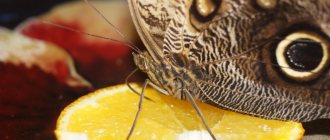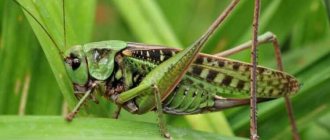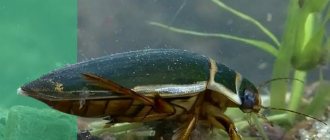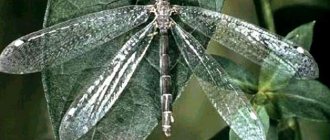What mole cricket larvae and adult insects look like
Adult insects lay up to 500 eggs during the mating season, which lasts from late May to mid-June. And in appearance, the dark brown eggs resemble millet seeds, and reach up to 3.5 mm in length.
In favorable conditions, larvae appear from them already on the 9-10th day. And in appearance they resemble adult insects, only without wings. Initially, the larvae reach up to 15 mm in length.
Adult mole crickets are larger. The length of their body reaches up to 50 mm, and the thickness is 12-15 mm. At the top it is brown-brown, and at the bottom it acquires a dark yellow tint. The surface of the body is covered with small, stiff hairs.
The mole cricket's mouthparts are a pair of powerful jaws. Next to them there are 4 tentacles, as well as 2 thread-like antennae. The insect's eyes are compounded, and they are located on the sides of the head.
The body of the pests is covered with a chitinous shell on the front. It not only protects the mole crickets from damage, but also helps in digging holes, because it is what they use to push out and compact the soil.
The abdomen consists of 10 tergites and 8 sternites. At its end there are anal and genital plates. The extreme segment has long and flexible tail appendages. Insects also have 2 pairs of wings and 6 limbs.
Reproduction
The mating period occurs in the spring and occurs underground. New offspring are born quickly; the first larvae appear already in the summer.
During the breeding season, mole crickets dig a complex network of passages and labyrinths under the plant, and they do this at a shallow depth (about 10-25 centimeters). Both the female and the male are engaged in this process. A small spherical nest is made under the roots, about the size of a chicken egg. There the female lays at least three hundred eggs (their number can increase to six hundred). They are oval in shape and small in size, about 2 mm. During this period, she carefully monitors the nest, protects it, compacts the walls, eats up the roots of plants that can cast a shadow or interfere, and also maintains normal air circulation and temperature.
The temperature regime is very important during this period; under good conditions, after about 15 days, the eggs hatch into cubs, who will live for another 1 month only under the supervision of the mother, without leaving the nest. After this, the female’s body is exhausted and she dies, and the cubs scatter and continue their development on their own, in particular, they dig tunnels and begin to look for food for themselves.
The larvae develop for a long time; depending on the region, the development time can vary from 1 year to 3 years. During the development period, they resemble an underdeveloped adult with a smaller size. They are also quite agile and can jump like grasshoppers; an adult mole cricket loses this ability. During the development period, they molt from 5 to 10 times.
Description of the pest, its life activity
The mole cricket (photos and descriptions of the larvae are given in the material for reference) live under the surface of the ground during the day.
At this time, the insect breaks through passages, simultaneously destroying plants encountered in its path. And at this time it can burrow to a depth of up to 100 cm.
The cabbage plant comes to the surface only at night. At this time, she moves to other areas in search of food. And the insect can fly long distances.
Adult cabbage mushroom overwinters at a depth of 1 m, and young individuals and larvae hibernate at a depth of 25-30 cm.
Lifestyle
They lead a secretive lifestyle. During the daytime, insects dig underground passages and eat plants and insects. The presence of the mole cricket in the garden is determined visually, the ground becomes covered with tubercles, these are underground tunnels that the mole cricket digs, holes appear in the ground and completely healthy crops can suddenly wither. This is because the insect eats the roots and the plant dies. At night they get out, during this period they can move between areas, and females can fly to the call of the male during the breeding season. They are also attracted to light. They run and fly quite quickly, and given that in nature these beetles often settle near bodies of water, they swim well. You can get acquainted with the appearance of the mole cricket beetle by looking at the photo below.
What harm does Medvedka cause to plants?
The mole cricket causes enormous damage to the crop. It gnaws through almost all flower, herbaceous and vegetable crops , which leads to their destruction, and also turns them onto the surface of the ground while making tunnels.
Mole cricket (photo and description) destroys plants by gnawing them
Insect larvae that feed on humus are also dangerous, which leads to soil depletion. And young cabbage weeds eat plant seeds planted in the ground.
origin of name
These insects became bearers of the title “mole crickets” for their large size, dark brown color, powerful front legs, and slightly downy body.
The second name of the individual is cabbage, attached due to its great love for the roots of young cabbage. Such a bug is also called a cricket - mole (translated from Latin), and for good reason - because the bug with its body structure fully resembles a cricket, it even creates a corresponding sound.
The name “mole” is also natural and quite logical - it is the front legs that help it easily overcome soil layers in search of the required food.
Also, a less common name is “top” - this name justifies its structure of the front legs. After all, they have sharp ends, slightly reminiscent of the sharp fangs of a wolf.
Which plants are susceptible to pest damage?
The diet of mole crickets is varied, and they can feed on a wide variety of plants:
- Vegetables: cabbage, beets, potatoes, tomatoes, onions, cucumbers, eggplants, radishes, peppers.
- Berries: watermelon, melon, strawberries, wild strawberries, grapes.
- Fruits: apple trees, pears, peaches, cherries, plums, apricots, cherries, peaches.
- Cereals: wheat, rye, corn, barley, rice, millet, soybeans.
Industrial crops are also not protected from mole crickets: flax, cotton, tobacco, hops, sunflower. The pest can also feed on the roots of young trees planted for decorative purposes, for example, spruce, oak, pine, and poplar.
Folk ways to get rid of mole crickets
Traditional methods help to destroy mole crickets on a personal plot, however, they do not provide a 100% guarantee. But such methods are safe, and after their use the products remain environmentally friendly.
Kerosene
The mole cricket (a photo and description of the insect larva is given later in the article) does not tolerate kerosene. And this substance can be used to control pests.
To do this, 100 g of kerosene must be diluted in 1 liter of water, and the resulting solution must be poured into the insect burrows. For each of them, 30 g of product is enough.
You can also mix kerosene with sand (200 ml per 10 l). The resulting mixture must be spread along the paths between the rows. And the composition will repel the pest from the beds.
Soapy water
Soapy water is an excellent insect repellent and can be used to lure pests out of hiding.
To do this you need to follow these instructions:
- Tar or laundry soap must be dissolved in water (100 g per 10 l).
- The resulting product must be poured in a thin stream into the pest’s holes. For each move, it is enough to use 2 liters of solution.
- After some time, the pests will begin to crawl out of their holes. At this time, they should be destroyed in any way, for example, by cutting them with a shovel. The insects remaining in the holes that cannot find a way out will die on their own.
For this method, you cannot use regular toilet soap and washing powder. These products contain phosphates and other harmful substances that are absorbed into the soil and then enter the crop.
Eggshell
To use eggshells to fight mole crickets, you will need to first dry them, crush them and mix them with unrefined sunflower oil. The resulting mixture should be spread into holes in which seeds will be sown or plants will be planted.
The mole cricket is sure to feast on the crushed shell, which will lead to damage to the pest’s digestive system, and then to its death. And the mixture wound up in the soil will become an excellent fertilizer for plants.
Onion peel infusion
The mole cricket (photos and descriptions of the pest larvae are given later in the article) categorically cannot stand the smell of onion peels. So it should be used to combat insects.
To do this, you need to fill the onion peel with water at a temperature of 50-60°C (800 g per 10 l). The mass should be covered with a lid and left in a warm place for 4-5 days.
The resulting solution must be diluted with clean water in a ratio of 1 to 5. Then the liquid needs to be sprayed on the places that the mole cricket visits.
To prevent the appearance of the pest, it is worth placing some onion peels in the holes when planting plants. And most likely, cabbage will bypass such beds.
Rotten fish versus cabbage
The smell of rotten fish disorients the mole cricket, and because of this “aroma” the pest does not find the roots of the plants. So when planting seedlings, it is worth placing several small fish in the hole; sprat and herring are suitable.
They will quickly go rotten and make the bed unsuitable for cabbage. In the future, you will need to periodically dig a new batch of fish into the ground, deepening it by 10 cm.
Sunflower oil
When sunflower oil gets on the shell scales, it causes them to stick together. As a result, it becomes difficult for insects to breathe. So this feature can be used in pest control.
To do this, prepare a solution by mixing vegetable oil with water (15 ml per 4 l) . It needs to be poured into the holes and passages of insects.
When the oil gets on the pests and causes problems with their breathing, the cabbage mushrooms will come out. And they can be easily collected and destroyed by throwing them into a bucket of kerosene or crushing them with a shovel.
Needles
The mole cricket cannot tolerate the smell of pine needles, and the pest practically does not appear in areas where pine or spruce trees grow. But if it is not possible to plant these trees, then you can use their branches to repel insects.
To do this, finely chop pine, spruce or fir needles and spread the resulting mass between the rows. You can also dig it a little into the ground, then it will retain its aroma longer.
It is worth considering that the method does not lead to the death of pests. And because of the needles, mole crickets can simply move to a free place. So it is better to spread the mass over the entire territory of the site.
Yeast or beer trap
The smell of an intoxicating drink attracts mole crickets, and this “sympathy” can be used to combat the pest. To do this, you will need to prepare several bottles with a wide neck. A regular milk container will do.
They must be dug in between the rows, positioned at an angle of 45°. Moreover, it is important that the necks of the bottles are located flush with the soil surface.
Next, you just need to fill the container 1/3 of the volume with an intoxicating drink. Mole crickets, sensing the smell of beer, will crawl inside the bottles, but will no longer be able to get out. And all that remains is to occasionally check the traps and destroy the pests caught in them.
It is also worth remembering that over time, the smell of an intoxicating drink dissipates and weakens. So every 7 days you need to add a new portion of beer to the traps.
Manure or compost trap
The mole cricket (photos and descriptions of the pest larvae will help you quickly recognize it) loves the smell of manure and often lays eggs in it. So it can be used to control the pest.
To do this in the fall, you need to make several trap holes around the perimeter of the garden, with dimensions of 50*50 cm, and fill them with manure, preferably horse manure.
The mole crickets will crawl inside for the winter, and when the cold comes, it will be enough to simply dig holes and pull the pests out. Then they will quickly die in the cold.
In the spring, you can simply lay out piles of manure, keeping a distance of 5-6 m between them. The mole crickets will crawl inside and lay eggs there. All that remains is to periodically check the piles, and if you find masonry there, you should immediately destroy it.
Water or sweet trap
You can destroy mole crickets using ordinary water and honey.
And to do this, just follow these instructions:
- An ordinary glass jar or bottle should be filled with water to 1/3 of its volume.
- The neck and inner surface of the container should be greased with a thin layer of honey.
- The jar must be dug into the ground at an angle of 45°. It is important that the neck of the dish is flush with the ground.
To achieve maximum results, you should build several similar traps on the site, placing them at a distance of 5-6 m from each other. As a result, the mole crickets will be attracted by the smell of honey, and they will crawl inside the dish to feast on the sweet mass.
But they will no longer be able to get out, and will drown in the water. All that remains is to periodically check the traps and remove dead insects.
Homemade fabric trap
In the summer heat, the mole cricket prefers to hide in the shade: under stones or leaves. And this feature of the pest can be used against it.
To do this, you will need to lay out a piece of dark fabric in several places on the site. Insects will definitely crawl under them in search of shade. And all that remains is to occasionally lift the material and check the trap, and if pests are detected, immediately destroy them.
In the spring, immediately after the snow melts, instead of fabric, you should lay out pieces of plywood, cardboard or boards around the area. Such traps will attract mole crickets, which will crawl under them in search of warmth.
Natural enemies
These insects have adapted well; they have few natural enemies. They can be eaten by some birds - rooks, hoopoes, starlings, crows; underground inhabitants - moles, shrews, lizards; some insects - ants, ground beetles, nematodes, mites, phorid flies. They are also susceptible to bacteriosis, which develops in damp or rainy weather and destroys them. Among earthly inhabitants, mole crickets are hunted by hedgehogs and cats.
Interesting fact! The larra anathema wasp drives the cabbage grass out of the ground, paralyzes it and lays eggs inside. After which the developing wasp larvae eat the mole cricket alive.
Similar articles:
Dry grass - a weed or an ornamental plant?...
How to fight mole crickets using chemistry and folk...
Insecticides are poisons and chemicals used to combat…
Chemical methods
The mole cricket, a photo and description of which is given in the article, is easily destroyed with the help of chemicals. Moreover, such products help get rid of not only adult cabbage weeds, but also their larvae.
And some drugs also additionally destroy garden ants, wireworms and other pests. And such means are considered the best.
| Features of the drug | Application | |
| "Medvetox" | The product is produced in the form of small red granules, and its active ingredient is diazinon. The drug does not destroy soil microflora and does not harm earthworms. | The granules should be buried in the soil to a depth of 3-5 cm. Some gardeners recommend moistening the product in vegetable oil to make it more attractive to the pest. The product begins to act 4 hours after being placed in the soil. And it protects the area from the invasion of mole crickets for 2-3 weeks. A package of product (100 g) is enough to treat 50 square meters. m plot. |
| "Antimedvedka" | The product is produced in the form of microgranules, and its main active ingredient is imidacloprid. Helps destroy mole crickets, cockchafer larvae, wireworms and black ants. Suitable for protecting all vegetable crops, with the exception of greens and radishes. | The drug must be spread between the rows. But it is better to dig it into the ground to a depth of 2-5 cm. Otherwise, birds or pets may feast on the poison. For processing 15 sq. m area, 20 g of the drug is enough. |
| "Medvecid" | Red granules, the main active ingredient of which is imidacloprid. The product effectively destroys mole crickets, as well as garden ants and beetle larvae. At the same time, the drug is safe and does not destroy the soil microflora. | The granules should be dug into the soil to a depth of 2-5 cm in places that the cabbage plant is supposed to visit. For prevention purposes, it is worth using the drug before sowing or planting plants. For processing 10 sq. m area you will need to use 100 g of the product. |
| "Rembek" | The drug is produced in the form of a grain mixture treated with insecticides (chlorpyrifos and imidacloprid). | The toxic mixture must be poured into the pest's holes, using 2-4 g (0.5 tsp) for each hole. After application, the exit should be compacted and the soil should be slightly moistened with water. A package of product (360 g) is enough for an area of up to 100 square meters. m. The garden will need to be treated with the drug 7-10 days before sowing and planting, as well as during the breeding season of the pest (late May - early June). |
| "Karbofos" | A pesticide that is produced in the form of a clear liquid or water-soluble white powder. And the main active ingredient of the drug is malathion. The insecticide perfectly destroys adult insects and their larvae, but does not harm oviposition. | Karbofos itself does not attract mole crickets, so you need to prepare poisonous semolina with this drug. To do this, boil wheat, barley or rye in salted water. For 1 kg of the resulting porridge you will need to add 20 g of vegetable oil (preferably unrefined) and 25 g of the drug. The product should be dug into the ground at the rate of 6-8 g per square meter. m plot. |
| Calcium carbide | This substance is not actually a pest control agent. But thanks to him, you can get rid of the mole cricket for a long time. | Having discovered pest tunnels, 5 g of the substance should be placed in each of them. Then you need to water the area. When interacting with water, calcium carbide will release acetylene. This poisonous gas will quickly fill the pest's passages, which will lead to the instant death of all cabbage mushrooms living there. |
Any chemicals intended to combat mole crickets are strong poisons. Therefore, when using them, safety precautions must be observed. Before processing, be sure to wear protective equipment: gloves, long sleeves and a respirator.
While using the medications, you should not drink, eat, or smoke. After the procedure, you need to wash your hands with soap and take a shower.
The event itself should be held on a cloudy, windless day, at a temperature no higher than +25 °C. The drugs must be stored in a place inaccessible to children and pets, and only in sealed packaging.
Biological drugs
Biological preparations are no less effective at destroying mole crickets than chemical ones. Such products contain fungus or special bacteria, which, when interacting with pests, lead to their death.
The best drugs of this type are considered:
- "Nemabact."
- "Boverin".
- "Entocide."
- "Ecokiller".
Biological agents are not dangerous for people, pets, and birds. In addition, they do not destroy the soil microflora and do not lead to the death of beneficial insects. And they can be used both for pest control and for prevention purposes.
Cereals
The mole cricket eats grains with pleasure. To combat it, it is recommended to use boiled wheat, mixing it with some insecticide at the rate of 2-3% by weight of the dry product.
The insect also feeds:
- oats;
- barley;
- rye;
The kapestyanka also likes corn. The beetle poses a danger to its seedlings. It is also known that in the absence of cereals, its fertility decreases.
Barriers for insects
To prevent pests from entering your garden or vegetable garden, you can create natural barriers. It is much easier and safer to plant plants with a pungent odor around the perimeter of the site that repel mole crickets.
The pest especially does not like the aroma of garlic, coriander, valerian, mint, chrysanthemums and marigolds.
Protective rings
Thanks to this method, plant seedlings can be protected from pests. To do this, you will need to prepare several plastic bottles with a volume of 1.5-2 liters. Mayonnaise buckets, dairy products glasses, and any plastic dishes with a height of 20 cm are also suitable.
The bottom of the workpieces must be cut off so that protective rings are formed. They should be buried in the ground so that the walls protrude 5 cm above the ground surface.
Then the mole crickets will not be able to crawl to the plants along the surface of the soil. It is necessary to plant seedlings inside the resulting protective rings, and they will be protected both from above and from below.
Fencing
The beds can be protected from mole crickets by digging sheets of plywood, boards or pieces of slate around them, as well as a mosquito net. Such limiters should go into the ground to a depth of 20-25 cm, and their upper part should rise above the soil surface by at least 5 cm.
Gardeners also advise putting nylon stockings on the roots of plants before planting them. But this method is quite time-consuming, especially if a large number of seedlings are planted.
Mechanical and electrical repellers
Electrical and mechanical repellers are often used to combat mole crickets. Such devices help repel insects, and at the same time they are harmless to health and do not harm the soil and crops.
But repellers have several disadvantages. First of all, they do not destroy pests, but only force them to move to another area, which will not please the neighbors at all.
And the effect of repellers appears after 10-14 days. And during this time, the pest can destroy a significant part of the crop. Another disadvantage is that repellers must work non-stop all season. Otherwise, the insects will return to the site.
Where does it come from?
Where does the mole cricket come from in the garden? Often it ends up on a plot of land along with manure in which the larvae of this pest live. It can migrate from neighboring areas if yours has higher soil moisture and nutritional properties.
Not only insects can cause irreparable damage to your plantings. On our website you can find useful information about other garden pests. Read all about wild rats, shrews, moles, bats and mice, gophers, wild hamsters. And also about ways to combat wireworms, locusts, whiteflies, sawflies and carrot flies.
Prevention
The mole cricket can be removed from the site, but it is not a fact that the pest will not return again.
And to prevent this from happening, it is better to take the following preventive measures:
- In early spring and late autumn, you should dig up the soil to a depth of at least 25 cm. Thanks to such measures, you can destroy possible clutches of pest eggs and adult individuals.
- Along the perimeter of the site it is worth planting plants that the mole cricket cannot tolerate. These include alder and bird cherry.
Preventing the appearance of mole crickets
You can also use branches of these crops, which will need to be stuck into the ground in different places in the garden. It is also worth planting marigolds, chrysanthemums and calendula on the site. These flowers repel pests.
- Before sowing and planting, the holes should be shed with iodine solution. It is also advisable to put a clove of garlic in each cavity. Crop seeds need to be treated with fungicides.
- The perimeter of the site, paths and row spacings must be sprinkled with sand and kerosene.
- During the growth of plants, they, as well as the soil in the garden bed, should be periodically sprayed with an infusion of onion peels.
Mole crickets are dangerous pests that can destroy almost the entire crop in a short period of time. Moreover, insects and their larvae, which, judging by the photo and description, look threatening, damage both the underground and above-ground parts of plants.
So you need to fight them at the first signs of their appearance. Better yet, prevent pests.
Is there any benefit
Despite the dislike of mole crickets for damaging the crop, gardeners note one positive aspect from the presence of insects on the site. By making moves, mole crickets help enrich the soil with oxygen, which roots and microorganisms need.
Fishermen use pests as bait when fishing for catfish, burbot, barbel, and ide. And citizens of Asian countries eat, prepare delicacies and seasonings, fry, marinate and stew.
But the beneficial properties are not comparable to the harm that the pest causes to plants and crops.
